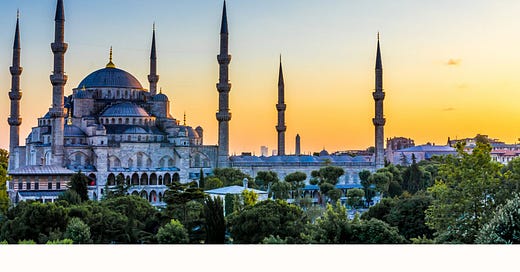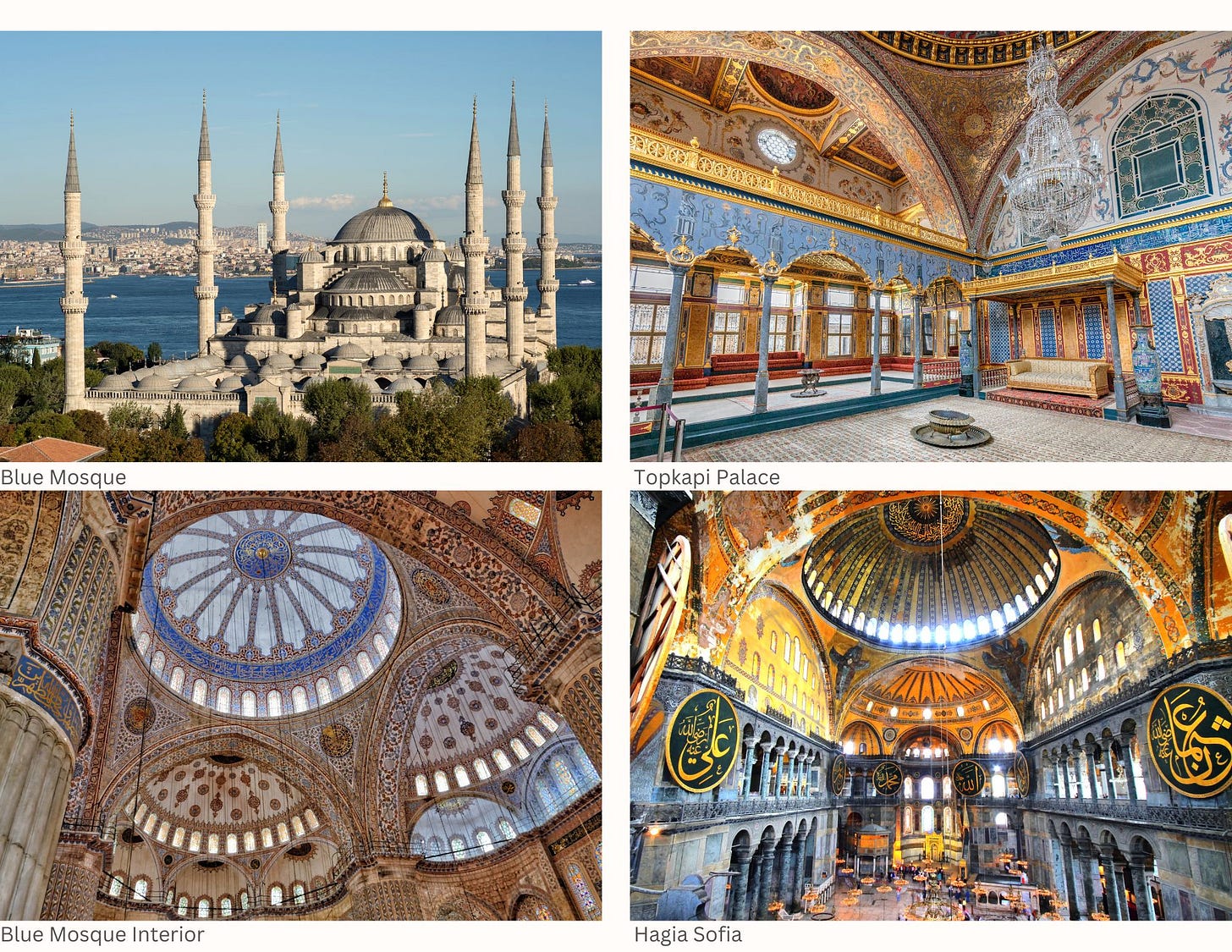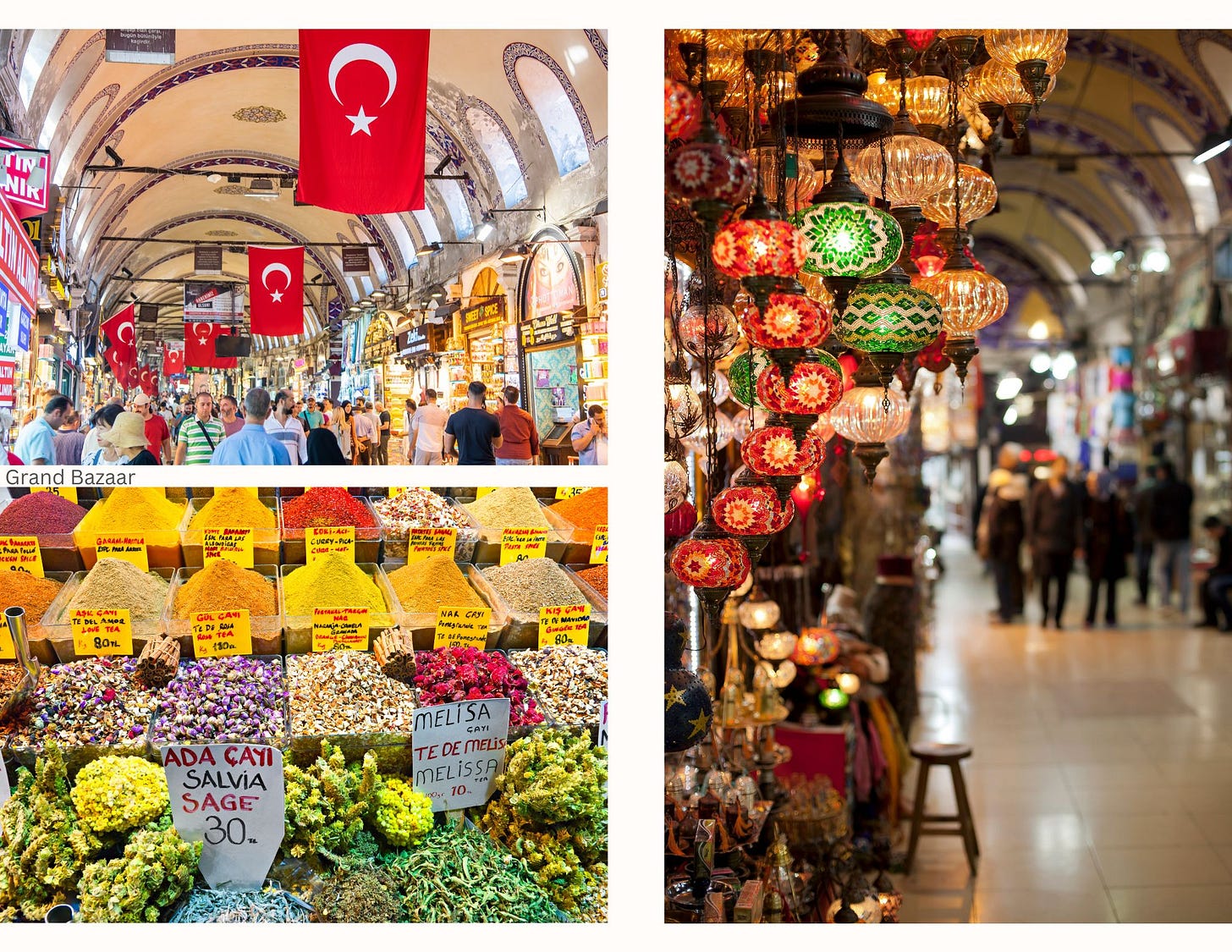Istanbul
With so many options in where to stay, what to see, where to eat and shop, and who is the best guide require choices to be made. Here are ours.
Have you considered a destination just a bit more challenging for your next trip? A bit exotic but accessible? Historic, dynamic, ancient, and modern all at the same time?
Istanbul. Once called Byzantium, then Constantinople, the city took its current name in 1923. That is just recent history. For 3,000 years, the Greeks, Romans, Crusaders, Ottomans, and others shaped this remarkable city that joins Europe and Asia, separated by the Bosphorus. The cut joins the Sea of Marmara to the Black Sea.
We have been to Istanbul a few times. Early visits were business related, with little time off for exploring. More recently, in April of 2022, exploring was our only goal. As usual, we scoured websites and travel blogs for the best way to spend seven days and nights. Important as we were traveling with friends from Toronto who had never been. This visit was to see the great sites, eat and shop. It was the end of our journey, having spent three weeks in Greece (more on that in the next post).
We found that Turkish Airlines offered a great price on Business Class seats from Singapore that allowed a brief stop on the way to Athens and a 7-day stop in Istanbul on the way home. Turkish Airlines also had flights direct from Toronto for our travel mates. The airline is a delight, and the new Ataturk airport is modern and expansive, almost overwhelming. All our research was helpful, but it was a bit of this and a bit of that over many hours. Nothing beats a first-hand, on-the-ground experience, and here is ours.
Turkish Airlines is a delight; the new Ataturk airport in Istanbul aims to become a global gateway hub, and it is a pleasure.
There are too many things to see in Istanbul in just seven days. Three thousand years of history require choices to be made: where to stay, what to see, where to eat, and all the usual stuff. But there is more.
We have stayed in everything from 5 stars to no stars in our travels. Airbnb’s to tented camps. Eaten in palaces and off the ground. Istanbul is blessed with an enormous variety of choices, but it does come down to access; to what neighborhood best suits your schedule. And Istanbul's schedule has more than a few options.
TIP: Ideally allocate 4-5 days in Istanbul to make the most of it. In case you have additional time, consider visiting Bodrum, and Cappadocia, but start your trip in Istanbul.
What you must see and do, in no particular order.
The Blue Mosque. Formally known as the Sultan Ahmed Mosque, it was built by the Ottomans in 1609, directly across from the mosque of Hagia Sophia. The blue is from 20,000 blue tiles in the interior, and the blue light bathes the structure at night. There are 200 intricate stained glass windows allowing light in that complement the chandeliers (once stuffed with ostrich eggs to keep spiders from building webs). This reverted to an actual mosque from a museum in 2020 and remained a must-see on any Istanbul list.
Opens 9 am - 7 pm, 7 days a week.
Hagia Sophia. Originally a Christian church built by the Roman Emperor Constantine over 100 years before the Blue Mosque, it was converted to a mosque in 1453 after the Ottoman takeover. In 2020, Turkish President Erdogan decreed it would end its status as a museum and become a working mosque again. The Christian artifacts would be protected, and visitors of all faiths are welcome outside of prayer times. It is second only to the Blue Mosque for its extraordinary architecture.
Opens 24 hours, 7 days a week.
TIP: Ladies should dress conservatively and bring head scarves to visit mosques. Shoes are not allowed in the mosques, so you will have to leave them at the entrance in shoe racks. They are safe but do remember where you left them as it can sometimes be hard to tell amongst the sea of shoes or bring your own shoe bags, so you have your shoes with you at all times.
Topkapi Palace. This stunning complex was built in 1459. It consists of not one but many buildings centered around four entry courtyards, each one less accessible than the one before. It was rebuilt after the earthquake of 1509 and the fire of 1665 that burned the enormous kitchens. The kitchens fed over 4,000 people a day and had 800 staff who lived on site. You can see the row of 20 double chimneys from the first courtyard. Today it is home to one of the most extensive collections of Chinese porcelain in the world, with over 10,700 pieces. Since the Forbidden City in Beijing was built almost 100 years before Topkapi, some say the latter was influenced by the multiple courtyard design of the Chinese palace. We know that Ottoman emissaries were in Beijing, thus all the porcelain. No one knows for sure.
Aside from the kitchens, there is a fabulous museum; not big, but every piece is stunning. That includes the Spoonmaker’s Diamond. This pear-shaped, 86-carat diamond has a remarkable history. The problem is, no one knows if it’s true. The diamond came into the possession of Sultan Selim III around 1800. The story goes that it was found by a fisherman who traded it for three wooden spoons to an unscrupulous gem dealer. Thus, the name Spoonmaker. You can also visit the Harem, the circumcision room, and other areas but just a tiny fraction of the complex overall. The Museum alone is worth the visit. You can also see the emerald-encrusted dagger that formed the plot of Topkapi, the movie with Peter Ustinov and Melina Mercouri. You have to see this place.
Opens from 10 am to 4 pm, except on Tuesdays.
TIP: Every April 1st to 30th is the Istanbul Tulip Festival. The city government has planted 30 million tulips in parks, avenues, and traffic roundabouts, including over a half-million planted as a huge "flower carpet" in Sultanahmet's Hippodrome in front of the Blue Mosque. The tulip is one of Istanbul's traditional symbols. Brought to the city from Iran centuries ago, then made their way from Istanbul to Europe and Holland.
The Grand Bazaar. Wow! It is both a tourist trap and a fantastic treasure trove. You have to go but get a guide (more on that later). There has been a market in this space since the early 1400s, but today’s configuration has been undergoing extensive renovations since 2012. For example, until then, there were no toilets! Why a guide? There are 61 covered streets and over 4,000 shops selling antiques, carpets, leather goods, and everything imaginable under one, well under 61 roofs. It’s a maze, and only a pro can direct you to the better offerings and shops. We’ve got one and she is fabulous. Find her in our Black Book.
Opens from 8:30 to 19:00, except Sundays and the first day of religious holidays.
OK, these are the must-sees. But, according to your tastes, there is SO much more! The Spice Market. The new Galata Port shopping and eating complex on the Bosphorus. The huge underground cisterns, the largest of which is the ‘Basilica Cistern.’ You can go to see the ‘Whirling Dervishes’ spin into a trance. And then, the shopping. Not just ancient stuff but very modern, contemporary home furnishings, linens, incredible Turkish delights, spices, Kebob stalls, and the one thing you must do. Go to a Hammam. A centuries-old tradition in Turkey, there are hundreds of Hammam’s (bath houses) in Istanbul, but we think we found the best one for couples, courtesy of our excellent hotel front desk.
It is perfect—all-white marble with attendants in head-to-toe white. Every guest has his or her’s own kit, including disposable bathing attire, towels, and a Kesa, the scrubbing mitt. You are escorted to the large domed room, the Kubbe. Then, doused in warm water from the Kurna and exfoliated. The Kurna is a marble basin with no drain. The warm water constantly overflows, so every splash they pour on you is fresh. Then, onto the heated, white marble Gobek Tasi for your scrub, including a foot-thick carpet of foaming bubbles. Finally, if you wish, on to a massage in a private room. All this for 90 Euros. Other Hammams cost more or less, but this one was very much to our taste: spotless, hospital white, and guaranteed to deliver the best afternoon nap ever.
Stay
Istanbul has hundreds of choices; it is a huge city of over 15 million people. In fact, it has nearly 1,000 hotels of every description. Hotel hospitality began in the 19th Century when the Orient Express extended its reach to Istanbul on June 1st, 1889.
It is important to pick a neighborhood that provides easy access to the things you want to do, preferably not deep in the old town but on or near the Bosphorus coastline, where traffic can be horrendous.
Although we looked at several impressive Airbnbs, we struggled to find one that aligned with our preferred location. Nonetheless, it's worth exploring your options. If you’re not very acquainted with Istanbul, the concierge services of a good hotel can be a lifesaver.
The Cihangir area is super trendy, with many shops, cafes, and restaurants. It is up a steep hill from the tram stop, but that just means gravity gets you down quicker.
We spent five delicious nights at the perfect hotel for us in Cihangir but decided to lux out for our last two. Big mistake. We chose the Ciragan Palace Kempinski Istanbul right on the Bosphorus, which is highly regarded and rated the number one choice in Istanbul, along with the two wonderful Four Seasons properties. Let me say the standard room is very Holiday Inn for over twice the price of our first hotel. Breakfast is cheerless. The staff is aloof. OK, the pool is heated, but that was the ONLY thing we liked about it. Just a few minutes walk away is the Four Seasons. Delightful but even more money at four times the price of our first hotel! Of course, there are other good choices, many five stars to choose from, and we list a few below.
Eat
The better question is where to start. This is an eating town from the ubiquitous Kepab (Turkish for Kebob) shops to high-end lux spots overlooking the city and/or the Bosphorus. There are over 23,000 restaurants, 10,000 more than in London. The high-end hotels are great for a signature view and a 5-star meal, but they are not cheap. Fortunately, Istanbul is jam-packed with great restaurants in every neighborhood at much more reasonable prices. In fact, prices are SO reasonable you will be amazed.
Our dining choices range from the fab Kepab shop in Cihangir, a stone’s throw from our first hotel to high-end spots with stunning views of Istanbul, to a famed Bodrum fish restaurant now with an outlet in Galataport.
TIP: Be sure to make dinner reservations in advance in the better places to make the most of your experience.
We did our final night at an Igloo at the Four Seasons Bosphorus. A free-standing canvas and glass hut on the water seating 8 with aircon and Bluetooth speakers. Food was brought by servers (our poor guys had to do it in the pouring rain), and, as it was a post-Ramadan feast, we were embarrassed at how little we could eat. We barely got through the appetizers, and there were five courses to follow. Expensive (just breathing at the Four Seasons costs money), but it is an experience we won’t forget.
A few other things
You will want to cruise the Bosphorus. We would have never gone to the new Galataport redevelopment if we hadn’t seen it from the boat. There are so very many boat choices and many not so good. We picked one, paid, went aboard, and left. Too big, too shabby. There are several “touts” selling tours on much smaller boats on the seawall. We found a good guy, made a deal, and the four of us went off on a 50-foot cabin cruiser with our own guide. You see all the stunning palaces on the river, both sides, Asian and European. Shop around, ask questions, and avoid the big boats.
Use the tram. It’s easy, and in a city with terrible traffic, it gets you around town easily and across the Bosphorus in just minutes.
Tip: You will need a magnetic card (Istanbul Kart) to use the tram. You can buy the cards in the small kiosks near all metro stations, piers, and bus stations, or your hotel concierge may have some on hand. You add credit to the cards at the ticket machines located at the entrance to the tram stations. You can share a card as well. The only hassle is you need to pass the card back to the next person entering the turnstile.
Get a guide
Istanbul is a very big city with much to see. Even if you just pick the places we suggest over 4-5 days to get the most out of the experience, you really need a guide. Wandering with a book doesn’t do these places justice. A great guide has stories that give life to these ancient places, and we found just that person. Book a guide through your hotel (or preferably with our guide in our Black Book) for a full day in the historic city, where you can visit Grand Bazaar, Blue Mosque, and/or Hagia Sophia.
Before you go
In 2023 Turkey suffered a terrible earthquake that killed many thousands and shipwrecked the already shaky economy. With Federal Elections coming up later this year, it could even put President Erdogan’s long, 18-year tenure in jeopardy. While the earthquake was a long way from Istanbul on the Syrian border, politics are everywhere. Ask us if you are considering going, we can find out from our friends there what’s going on.
That’s been important to watch for a while as the Turkish economy has been in serious trouble. Good for visitors and bad for the Turkish people. This stems from President Erdogan’s refusal to raise interest rates to fight rampant inflation. In fact, against every economist’s belief system, he has lowered them! As a result, the October 2022 monthly inflation rate was 85.51 %!!! As of February 2023, it is 55.18%. Elections are this year, but the Turkish people simply can’t survive these numbers month after month. In our week in October 2022, the price of gas went up 300%. In 7 days!!! Make sure you do some research on the state of the economy before you go. People might take to the streets in protest, and Erdogan is tough; he won’t stand for widespread dissent. This definitely one place that requires a deep dive into their politics and economy before you go. That aside, we found Istanbul very safe in late 2022, and all the people we met were warm and helpful.
Follow us on our next adventure to the birth of western civilization and a surprisingly fabulous eating town.
(Visited April/October 2022)








